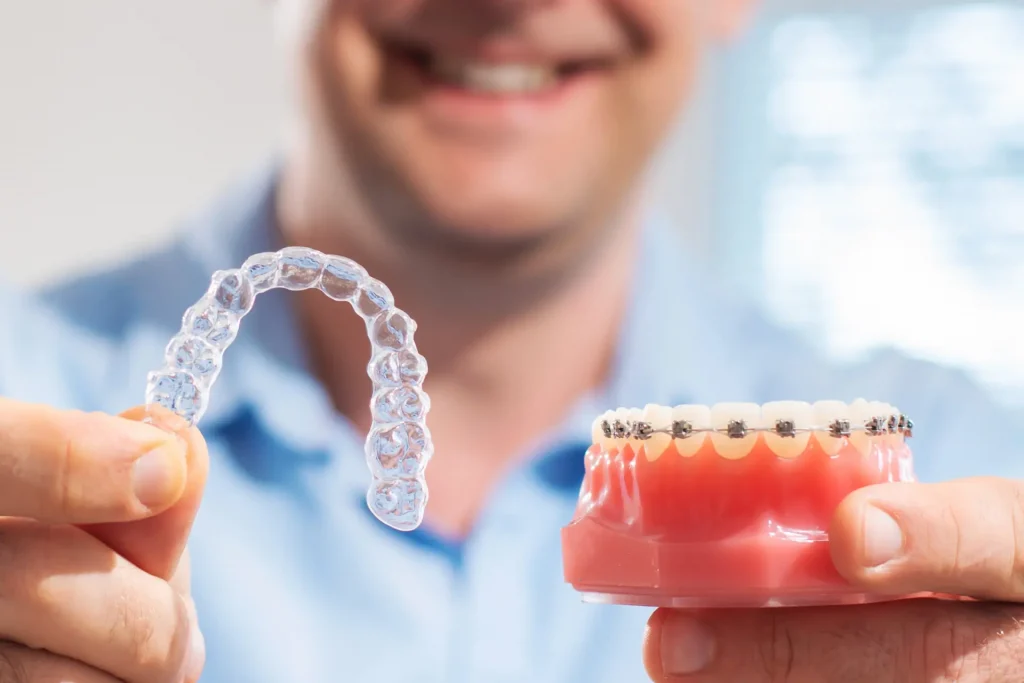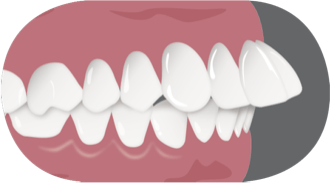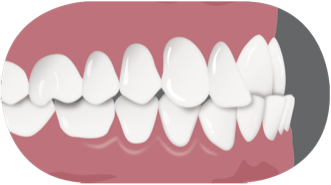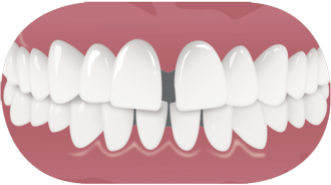
Braces are orthodontic devices that correct issues with the teeth, such as crowding, crooked teeth or teeth with gaps between them. They work by applying gentle pressure to the teeth, which cause the teeth, bone and muscles in the mouth to move into a new position over time.
After the course of their orthodontic treatment, the wearer will be left with straighter teeth, which not only look better, but will be easier to brush and floss. This means the wearer can practise better dental hygiene and enjoy improved oral health once their braces come off.
Braces can correct a whole host of common bite problems, including:

This is when the upper teeth sit too far over the bottom teeth, leaving a large overlap that can wear down the incisors. Overbite can also damage the tissue of the gums, and can result in a gummy smile. The severity of an overbite can vary massively, but most kinds of braces, including clear aligners, can fix the issue.

Also known as anterior crossbite, this is where the lower jaw and teeth sit in front of the upper. This kind of maloccusion can cause major stress on the joints, and can lead to headaches and even temporomandibular disorder (TMD). Braces can be used to treat underbite in most cases, though the patient may also need surgery to reshape the jaw.
Crossbite can affect one tooth or multiple, and this is where the upper teeth can fit in between the lower teeth. Crossbite will cause chewing and biting problems, and the issue will worsen over time if not treated. Most kinds of braces will be able to fix crossbite, although this will depend on the severity of the case.
Crowding happens when there isn’t enough space in your mouth for your teeth to align correctly. This form of malocclusion makes it difficult for a person to brush and floss, and can lead to cavities, tooth decay, or more complex health problems. Braces are a very effective treatment for most cases of crowded teeth.

Like the opposite of crowding, spacing presents gaps between the teeth that expose the gums. Plaque and food particles can build up around these wide spaces if not looked after properly, and this can put a person at higher risk of cavities and gum disease. Most forms of braces are able to treat gapped teeth effectively, but this depends on the severity of the case.
There are a variety of modern braces to choose from, and traditional metal braces are no longer the only choice. Depending on the severity of a person’s malocclusion, some types of braces may be better more suitable than others. The only way to decide which orthodontic treatment is best for you is to consult an expert dentist or orthodontist.
If your clinician decides that braces are indeed the best solution, they will tell you which kind is most suitable. Here are the main types of braces.
Unfavourably dubbed as ‘train tracks’, traditional metal braces have been around for over 100 years, and are still a very popular form of orthodontic treatment.
Metal braces consist of wires and brackets, which are stuck to the teeth and connected with coloured elastic ties. These braces must be manually tightened by an orthodontist, meaning patients must make dental appointments fairly regularly.
Traditional metal braces are not removable, and this makes them an attractive choice for teens and children who may refuse or forget to wear them. But their permanence also requires extra care and attention when brushing to maintain good oral hygiene. Certain foods must also be avoided when wearing metal braces to prevent damage and food from getting stuck.
Similar to metal braces, ceramic braces use clear or tooth-coloured components, rather than metallic brackets and wires. They’re an attractive alternative to traditional braces as they are slightly less noticeable. Aside from the colour, ceramic braces work in the exact same way as traditional braces, and are not removable.
While traditional braces are held together by elastic ties, the wires in self-litigating braces are held in place by brackets or clips. This means self litigating braces are always actively moving the teeth, and don’t require manual tightening. Self-litigating braces are also not removable and will stay on the patient’s teeth until the treatment is complete.
Lingual braces sit behind the teeth, rather than on the front, and so they are invisible when you are smiling, talking and eating. They are suitable for all ages, and their discreetness makes them an attractive option for adults and teens alike.
Like traditional braces, lingual braces are made of brackets and wires, and need to be manually adjusted every few weeks. The only difference between lingual braces and metal braces is their position on the teeth mouth.
There are two kinds of lingual braces:
These braces focus on the front six to eight teeth (the ‘social six’), and are ideal for cosmetic fixes, including small gaps in the teeth.
Suitable for crowded, gapped, or crooked teeth, and designed to align the whole arch.
Neither kinds of lingual braces are removable, and will remain on the patient’s teeth until the end of the treatment period.
Clear aligners, such as those made by ClearCorrect, are invisible braces that look like retainers. They are custom moulded to the patient’s dental impression, and are a very effective way to achieve straighter teeth.
As they’re virtually invisible to the naked eye, clear aligners are ideal for adults and teens who are conscious about their appearance. Clear aligners are removable, but they must be worn for 22 hours a day to prevent prolonged treatment or complications. They should only be removed to brush, eat, drink fluids other than water, and clear the aligners themselves.
Clear aligners are suitable for anyone who has a full set of adult teeth, and can treat most common malocclusions effectively, including crossbite, overbite and open bite.
Being made of ultra-thin, flexible plastic that wraps around the patient’s teeth well, clear aligners, are also very comfortable to wear in comparison to traditional fixed braces. Those who wear clear aligners do not have to restrict their food choices either, and can brush and floss their teeth effectively. This means that people who wear clear aligners can practise good oral hygiene throughout the couse of their treatment.

Many factors will affect your suitability for certain forms of braces, including the severity of your malocclusion and the amount of adult teeth you have. The only way to tell which kind of braces is best suited to your case is by speaking to a dentist or orthodontist. They’ll be able to give you a reasonable estimate of price and length of your treatment, and advise on your funding options too.
Why not book an appointment with one of our experts and take action toward a healthier, happier smile?